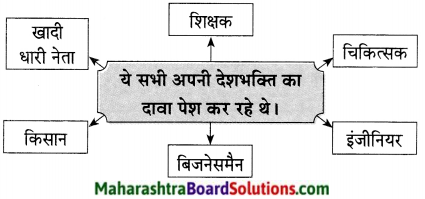Std 9 Hindi Chapter 2 Billi Ka Bilanguda Question Answer Maharashtra Board
Balbharti Maharashtra State Board Class 9 Hindi Solutions Lokbharti Chapter 2 बिल्ली का बिलुंगड़ा Notes, Textbook Exercise Important Questions and Answers.
Hindi Lokbharti 9th Digest Chapter 2 बिल्ली का बिलुंगड़ा Questions And Answers
Hindi Lokbharti 9th Std Digest Chapter 2 बिल्ली का बिलुंगड़ा Textbook Questions and Answers
1. सूचनानुसार कृतियाँ कीजिए :
(क) संजाल
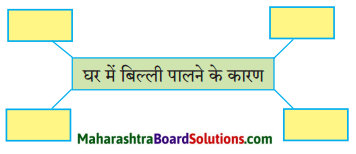
(ख) कहानी के प्रमुख पत्र
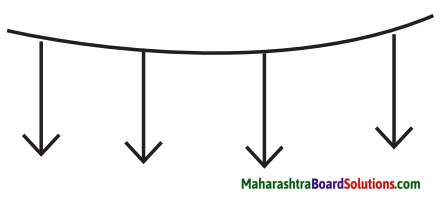
प्रश्न क.
संजाल

उत्तर:

प्रश्न ख.
कहानी के प्रमुख पत्र

उत्तर:
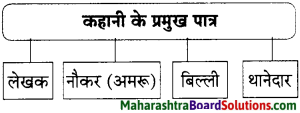
2. उत्तर लिखिए :
बिल्ली के रवैये में आया परिवर्तन।
1. ………………………
2. …………………….
प्रश्न 1.
बिल्ली के रवैये में आया परिवर्तन।
उत्तर:
i. वह घर के सदस्यों के आगे-पीछे फिरने के बजाय रसोई के आसपास कोने में दुबक कर बैठ जाती।
ii. मौका मिलते ही मनचाही चीज खा लेना।
3. स्पष्ट कीजिए :
घर के सदस्यों का बिल्ली के प्रति व्यवहार
पहले और बाद में –
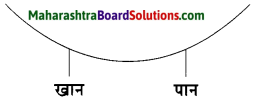
प्रश्न 1.
घर के सदस्यों का बिल्ली के प्रति व्यवहार
पहले और बाद में –

उत्तर:
- खान – पहले – बच्चे कभी-कभी रोटी देते। थाली का जूठन खिलाते।
- बाद में – चोरी से मनचाही चीज खाना।
- पान – पहले – बच्चे कभी-कभी दुध पिलाते।
- बाद में – चोरी से दूध-दही खाना।
![]()
पाठ से आगे :
‘प्राणी हमसे कहते हैं जियो और जीने दो’, इस विषय पर स्वमत प्रकट कीजिए।
प्रश्न 1.
‘प्राणी हमसे कहते हैं जियो और जीने दो’, इस विषय पर स्वमत प्रकट कीजिए।
उत्तरः
“जियो और जीने दो’ ये दो शब्द हैं, किंतु इन दो शब्दों में जिंदगी का सार भरा है । प्रकृति ने सबको जीने का समान अधिकार दिया है। हम किसी का अनिष्ट करेंगे तो हमारा भी अनिष्ट निश्चित है। इंसान, इंसान के रूप में जन्म तो लेता है किंतु उसके कर्म इंसानों जैसे नहीं होते। वह अपनी आवश्यकताओं की पूर्ति के लिए अन्य प्राणियों का दोहन करता है। जंगलों की कटाई करता है। यदि हम ऐसा करेंगे, तो इससे हमारा ही नुकसान होगा। बारिश नहीं होगी और वन्य प्राणी भी जंगल कट जाने से गाँवों में घुस आएँगे और हम पर हिंसक आक्रमण कर देंगे। भाषाई कौशल पर आधारित पाठगत कृतियाँ |
![]()
भाषा बिंदु :
शब्द कोश की सहायता से रेखांकित शब्दों के विलोम खोजिए तथा उनसे नए वाक्य लिखिए।
प्रश्न 1.
शब्द कोश की सहायता से रेखांकित शब्दों के विलोम खोजिए तथा उनसे नए वाक्य लिखिए।
- बिल्ली भी कम समझदार जानवर नहीं है।
- अमरू स्वभाव से अल्पभाषी है।
- पुरानी विचार धारा और पंरपरा एकदम घपले में पड़ गई है।
- अब हम उसे दुत्कार रहे हैं।
- दसियों ने इस सुंदर प्रस्ताव का समर्थन किया।
- डायनासोर प्राणी अब दुर्लभ हो गए हैं।
- वह तटस्थ होकर अपने विचार रखता है।
- इस भौतिक जीवन में मनुष्य बहुत खुश है।
- गर्मियों में सारी धरती शुष्क हो जाती है।
- पैसों का अपव्यय नहीं करना चाहिए।
उत्तरः
- गधा नासमझ होता है।
- आजकल के नेता बहुत वाचाल होते हैं।
- आज की युवा पीढ़ी नई विचार धारा को तेजी से अपना रही है।
- हम अपने अतिथियों का बहुत सत्कार करते हैं।
- जनता ने सरकार की गलत नीतियों का विरोध किया।
- जनता दरबार में मुख्यमंत्री से बात करना सुलभ हो गया है।
- मंत्री जी योजनाएं लागू करने में पक्षपात करते हैं।
- संत आध्यात्मिक जीवन में खुश रहते हैं।
- वर्षा के समय सारी पृथ्वी हरी-भरी हो जाती है।
- हमें मैंहगाई को देखते हुए पैसों का मितव्यय करना चाहिए।
Hindi Lokbharti 9th Answers Chapter 2 बिल्ली का बिलुंगड़ा Additional Important Questions and Answers
(क) परिच्छेद पढ़कर दी गई सूचना के अनुसार कृतियाँ कीजिए।
कृति (3) शब्द संपदा
प्रश्न 1.
परिच्छेद से समानार्थी शब्द ढूँढकर लिखिए।
i. प्रसन्न
ii. कोशिश
उत्तर:
i. खुश
ii. प्रयत्न
प्रश्न 2.
वचन परिवर्तन कीजिए।
i. चूहा
ii. बिल्लियाँ
उत्तर:
i. चूहे
ii. बिल्ली
![]()
प्रश्न 3.
विरुद्धार्थी शब्द लिखिए।
i. पुरानी × ……..
ii. आपत्ति × …..
उत्तर:
i. नई
ii. सहमति
कृति (4) स्वमत अभिव्यक्ति
प्रश्न 1.
‘चूहों से हानि’ इस विषय पर अपने विचार लिखिए।
उत्तर :
अक्सर हम अपने घरों में चूहों की वजह से बहुत परेशान रहते हैं, वे घर में अपने पैरों में लगी गंदगी और मल-मूत्र के माध्यम से बीमारी फैलाते हैं। चूहे घर में रखें अनाज, खाद्य सामग्री के साथ ही जूते, कपड़े, किताबें आदि काटकर बहुत नुकसान करते हैं। वास्तुशास्त्र के अनुसार चूहा नकारात्मक और अज्ञानी शक्तियों का प्रतीक भी माना जाता है। चूहों की मौजूदगी से घर में मौजूद लोगों की बुद्धि का भी विनाश होता है।
(ख) परिच्छेद पढ़कर दी गई सूचना के अनुसार कतियाँ कीजिए।
कृति (1) आकलन कृति
प्रश्न 1.
कृति पूर्ण कीजिए।
उत्तर :
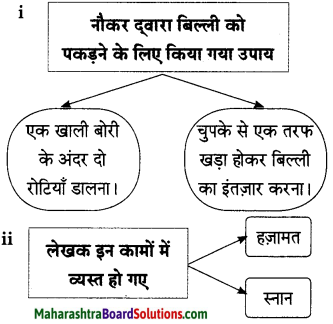
कृति (2) आकलन कृति
प्रश्न 1.
उपर्युक्त गद्यांश से दो ऐसे प्रश्न तैयार कीजिए जिनके
उत्तर
निम्नलिखित शब्द हों –
i. बोरी
ii. अमरू
उत्तर:
i. रस्सी से किसका मुंह बाँध दिया गया?
ii. बोरी कंधे पर लटकाकर कौन चल दिया?
![]()
प्रश्न 2.
सत्य या असत्य पहचानकर लिखिए।
i. लेखक को बिल्ली से पीछा छुड़ाने की चिंता हुई।
ii. नौकर ने तुरंत बोरी का एक सिरा पकड़कर उसे ऊपर से खोल दिया।
उत्तर:
i. सत्य
ii. असत्य
प्रश्न 3.
गद्यांश के आधार पर वाक्य पूर्ण कीजिए।
i. लेखक ने नौकर को याद दिलाया
ii. लेखक का ध्यान आवाज की तरफ नहीं गया
उत्तर:
i. लेखक ने नौकर को याद दिलाया कि उसे बिल्ली को भूली भटियारिन की तरफ छोड़ कर आना है।
ii. लेखक का ध्यान आवाज की तरफ नहीं गया, क्योंकि वह नहाने में व्यस्त था और कुछ गुनगुना रहा था।
कृति (3) शब्द संपदा
प्रश्न 1.
मानक वर्तनी के अनुसार सही शब्द लिखिए।
i. चिन्ता
ii. अन्दर
उत्तर:
i. चिंता
ii. अंदर
![]()
प्रश्न 2.
विलोम शब्द लिखिए।
i. होशियार × ……….
ii. रात × ………
उत्तर:
i. मूर्ख
ii. दिन
प्रश्न 3.
समानार्थी शब्द लिखिए।
i. दिन
ii. दफ्तर
उत्तर:
i. दिवस
ii. कार्यालय
![]()
कृति (4) स्वमत अभिव्यक्ति
प्रश्न 1.
पालतू जानवरों के प्रति हमें सौहार्दपूर्ण व्यवहार करना चाहिए।’ इस संबंध में अपने विचार लिखिए।
उत्तर:
जानवरों का मनुष्य के जीवन में बहुत महत्व है। गाय, बैल, भैंस, कुत्ता, घोड़ा आदि जानवर बहुत उपयोगी हैं। हमें उन्हें प्रेम से पालना चाहिए। ये जानवर हमारे साथ हमारे घर में रहकर परिवार के सदस्य जैसे बन जाते हैं। हमें उनके प्रति सौहार्दपूर्ण व्यवहार रखना चाहिए। उन्हें उचित समय पर अच्छी खुराक देनी चाहिए। उनकी साफसफाई का ध्यान रखना चाहिए। ये जानवर भी हमारे प्रति सद्व्यवहार और स्नेह रखते हैं। उनकी अच्छी देखभाल करना हमारा कर्तव्य है।
(ग) परिच्छेद पढ़कर दी गई सूचना के अनुसार कतियाँ कीजिए।
कृति (2) आकलन कृति
प्रश्न 1.
समझकर लिखिए। अमरू के स्वभाव की विशेषता –
उत्तर:
i. अल्पभाषी
ii. मसखरा
प्रश्न 2.
एक-एक शब्द में उत्तर लिखिए।
i. भीड़ ने अमरू पर यह चुराने का आरोप लगाया
ii. यहाँ से तो कई बच्चे उठाए जा चुके हैं
उत्तर:
i. बच्चा
ii. देवनगर
प्रश्न 3.
सत्य या असत्य पहचानकर लिखिए।
i. अमरू स्वभाव से अल्पभाषी था।
ii. एक आदमी लपककर अस्पताल गया।
उत्तर:
i. सत्य
ii. असत्य
![]()
प्रश्न 4.
सही विधान चुनकर पूर्ण वाक्य फिर से लिखिए।
1. लेखक समझा शायद अमरू किसी की ………..,
(क) कार से टकरा गया होगा।
(ख) साइकिल चुरा लिया होगा।
(ग) साइकिल से टकरा गया होगा।
उत्तर:
(ग) साइकिल से टकरा गया होगा।
2. कुछ लोगों को शक हुआ कि …………….।
(क) बोरी में बच्चा है।
(ख) अमरू चोर है।
(ग) बोरी में बिल्ली है।
उत्तर:
(क) बोरी में बच्चा है।
कृति (3) शब्द संपदा
प्रश्न 1.
समानार्थी शब्द लिखिए।
i. मुश्किल
ii. हवालात
उत्तर:
i. कठिन
ii. जेल
![]()
प्रश्न 2.
निम्नलिखित शब्दों के वचन परिवर्तन कीजिए।
i. आदमियों
ii. बच्चा
उत्तर:
i. आदमी
ii. बच्चे
प्रश्न 3.
मानक वर्तनी के अनुसार सही शब्द लिखिए।
i. अन्दर
ii. सुन्दर
उत्तर:
i. अंदर
ii. सुंदर
![]()
कृति (4) स्वमत अभिव्यक्ति
प्रश्न 1.
‘मूक जानवरों की हत्या करना बहुत बड़ा पाप होता है।’ इस पर आधारित अपने विचार लिखिए।
उत्तर:
जानवर देश की प्राकृतिक संपदा होते हैं। उनके कारण ही जंगलों की शोभा बढ़ती है। पर्यावरण का संतुलन बनाए रखने के लिए हमें मूक जानवरों की रक्षा करनी चाहिए। यदि हम उनकी हत्या करेंगे, तो उनका अस्तित्व खतरे में पड़ जाएगा। प्रत्येक जीव को इस धरती पर जीवन जीने का अधिकार है। हम किसी के भी अधिकार को छीन नहीं सकते हैं। यदि हम उनकी हत्या करते हैं, तो हम धर्म एवं कानून की नज़र में बहुत बड़े अपराधी बन जाते हैं। दूसरों की रक्षा करना हमारा सबसे बड़ा कर्तव्य होना चाहिए।
(घ) परिच्छेद पड़कर दी गई सूचना के अनुसार कृतियाँ कीजिए।
कृति (1) आकलन कृति
प्रश्न 1.
समझकर लिखिए।
बच्चों का खेलना-कूदना यहाँ बंद हो चुका था –
उत्तरः
i. पार्कों में
ii. बाहर गलियों में
प्रश्न 2.
वातावरण में इसकी कमी न थी –
उत्तर:
i. सनसनी
ii. तनाव
कृति (2) आकलन कृति
प्रश्न 1.
उपर्युक्त गद्यांश से दो ऐसे प्रश्न तैयार कीजिए जिनके उत्तर निम्नलिखित शब्द हों –
i. अमरू
ii. थानेदार
उत्तर:
i. थानेदार ने आते ही किसकी कलाई पकड़ ली?
ii. किसने आते ही अमरू की कलाई पकड़ ली?
![]()
प्रश्न 2.
सही पर्याय चुनकर पूर्ण वाक्य फिर से लिखिए।
1. उन दिनों दिल्ली में बड़ी …………….।
(क) महामारी फैली हुई थी।
(ख) भुखमरी फैली हुई थी।
(ग) सनसनी फैली हुई थी।
उत्तर:
(ग) सनसनी फैली हुई थी।
2. जमुना के पुल पर कुछ आदमी पकड़े गए …………….।
(क) जिन्होंने बोरियों में बच्चे बंद किए हुए थे ।
(ख) जिन्होंने मछलियाँ पकड़ी थी ।
(ग) जो चोरी करके भाग रहे थे ।
उत्तर:
(क) जिन्होंने बोरियों में बच्चे बंद किए हुए थे ।
कृति (3) शब्द संपदा
प्रश्न 1.
निम्नलिखित शब्दों के लिंग परिवर्तन कीजिए।
i. आदमी
ii. नौकर
उत्तर:
i. औरत
ii. नौकरानी
प्रश्न 2.
निम्नलिखित शब्दों के समानार्थी शब्द परिच्छेद से ढूँढकर लिखिए।
i. सतर्कता
ii. अचरज
उत्तर:
i. सावधानी
ii. आश्चर्य
![]()
प्रश्न 3.
विरुद्धार्थी शब्द लिखिए।
i. सवाल × …….
ii. संदेह × …….
उत्तर:
i. जवाब
ii. नि:संदेह
प्रश्न 4.
निम्नलिखित अव्यय शब्दों का अपने वाक्यों में प्रयोग कीजिए।
i. और
ii. कि
उत्तर:
i. रोटी चौका करता हूँ और अपना पेट पालता हूँ।
ii. एक दो बार समाचार पत्र में छपा कि जमुना के पुल पर कुछ आदमी पकड़े गए।
कृति (4) स्वमत अभिव्यक्ति
प्रश्न 1.
आजकल हो रहे बच्चों के अपहरण के संबंध में अपने विचार लिखिए।
उत्तर:
आजकल बच्चों के अपहरण के मामले तेजी से बढ़ रहे हैं। इनमें छोटे और मासूम बच्चों की संख्या अधिक होती है। इन बच्चों का पैसे के लिए, मानव तस्करी के लिए या बदला लेने के लिए अपहरण किया जाता है। अपहरण करने वाले अपने स्वार्थों के वशीभूत होकर बच्चों को सताने से भी बाज नहीं आते हैं। बच्चों का अपहरण करना सबसे सरल होता है क्योंकि वह छोटे होते हैं और इन पर काबू पाना सरल होता है। माता-पिता को बच्चों की सुरक्षा के लिए हर समय चिंतित रहना पड़ता है। पुलिस और सरकार तो इनके आगे बेबस होते नजर आती है। अत: इसके खिलाफ सरकार को कठोर कदम उठाने चाहिए और दोषियों को कड़ी से कड़ी सज़ा देनी चाहिए।
![]()
(ङ) परिच्छेद पढ़कर दी गई सूचना के अनुसार कृतियाँ कीजिए।
कृति (2) आकलन कृति
प्रश्न 1.
आकृति पूर्ण कीजिए।
उत्तरः
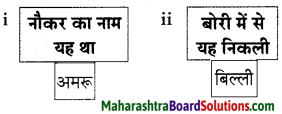
प्रश्न 2.
समझकर लिखिए।
थानेदार को बुलाकर लाने वाला व्यक्ति क्रोध में बोला
उत्तरः
क्यों बकता है, बे! दरोगा जी, ऐसे यह नहीं मानेगा। दो-चार बेंत रसीद कीजिए।
कृति (2) आकलन कृति
प्रश्न 1.
चौखट पूर्ण कीजिए।
उत्तरः
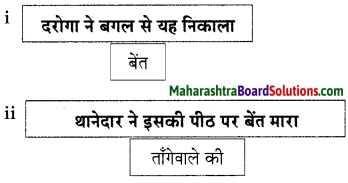
प्रश्न 2.
सत्य या असत्य पहचानकर लिखिए।
i. अमरू नम्रतापूर्वक दरोगा से बोला।
ii. दरोगा ने अमरू की पीठ पर बेंत मारा।
उत्तर:
i. सत्य
ii. असत्य
![]()
प्रश्न 3.
सही विधान चुनकर पूर्ण वाक्य फिर से लिखिए।
1. पहले यह तो देख लें कि .. …………..
(क) मेरा क्या कसूर है।
(ख) इस बोरों में है क्या?
(ग) इस बोरी में बिल्ली हैं।
उत्तर:
पहले यह तो देख लें कि इस बोरी में है क्या?
2. हम सब इस आदमी की …………….।
(क) बदमाशी के गवाह हैं।
(ख) सच्चाई के साथ हैं।
(ग) चोरी के खिलाफ हैं।
उत्तर:
हम सब इस आदमी की बदमाशी के गवाह हैं।
कृति (3) शब्द संपदा
प्रश्न 1.
समानार्थी शब्द लिखिए।
i. क्रोध
ii. हुक्म
उत्तर:
i. गुस्सा
ii. आदेश
प्रश्न 2.
विरुद्धार्थी शब्द लिखिए।
i. नीचे × ……….
ii. धीरे-से × ………
उत्तर:
i. ऊपर
ii. जोर-से
![]()
प्रश्न 3.
कृति पूर्ण कीजिए।
उत्तर:
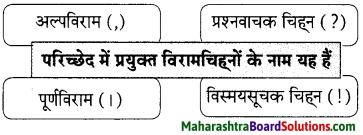
प्रश्न 4.
निम्नलिखित वाक्यों में उचित विरामचिह्नों का प्रयोग कीजिए।
i. क्रोध में आकर बोला क्यों बकता है बे दरोगा जी ऐसे नहीं यह मानेगा।
ii. उन्होंने अमरू से कहा अच्छा बोरी को नीचे रखो इसका मुँह खोलो।
उत्तर:
i. क्रोध में आकर बोला, “क्यों बकता है, बे! दरोगा जी, ऐसे नहीं यह मानेगा।”
ii. उन्होंने अमरू से कहा, “अच्छा, बोरी को नीचे रखो। इसका मुंह खोलो।”
प्रश्न 5.
निम्नलिखित वाक्यों में सूचना के अनुसार काल परिवर्तन कर फिर से लिखिए।
i. उनकी नीयत पर लोगों को शक हो रहा है। (सामान्य भविष्यकाल)
ii. अमरू शांतिपूर्वक नीचे बैठ गया। (सामान्य वर्तमानकाल)
उत्तर:
i. उनकी नीयत पर लोगों को शक होगा।
ii. अमरू शांतिपूर्वक नीचे बैठ जाता है।
कृति (4) स्वमत अभिव्यक्ति
प्रश्न 1.
निम्नलिखित वाक्यों में अव्यय पहचानिए और उसका नाम लिखिए।
- आटे और अनाज के लिए लोहे के ढोल बनवाए गए।
- बिल्ली खूब मजे से खा रही है।
- बिल्ली लोगों की थाली से जूठन ही खाती इसलिए हमें इसका कोई खर्च नहीं पड़ा।
उत्तर:
- और – समुच्चयबोधक अव्यय के लिए – संबधसूचक अव्यय
- मजे से – क्रियाविशेषण अव्यय
- इसलिए – समुच्चयबोधक अव्यय
![]()
प्रश्न 2.
निम्नलिखित वाक्यों को सूचना के अनुसार काल बदलकर फिर से लिखिए।
- बिल्ली रोटियों पर झपटी। (सामान्य वर्तमानकाल)
- अमरू कंधे पर बोरी लटकाकर चल दिया। (अपूर्ण भूतकाल)
- बिल्ली कमरे में आती है। (सामान्य भूतकाल)
- उनकी नीयत पर लोगों को शक हो रहा है। (सामान्य भविष्यकाल)
- अमरू शांतिपूर्वक नीचे बैठ गया। (सामान्य वर्तमानकाल)
उत्तर:
- बिल्ली रोटियों पर झपटती है।
- अमरू कंधे पर बोरी लटकाकर चल रहा था।
- बिल्ली कमरे में आई।
- उनकी नीयत पर लोगों को शक होगा।
- अमरू शांतिपूर्वक नीचे बैठ जाता है।
प्रश्न 3.
निम्नलिखित अशुद्ध वाक्यों को शुद्ध करके लिखिए।
i. अमरू के कुछ कहना नहीं पड़ी।
ii. उन्होंने देखा की बोरी अंदर में हिल रही है।
उत्तर:
i. अमरू को कुछ कहना नहीं पड़ा।
ii. उन्होंने देखा कि बोरी अंदर से हिल रही है।
प्रश्न 4.
निम्नलिखित अव्यय शब्दों का अपने वाक्यों में प्रयोग कीजिए।
i. और
ii. कि
उत्तर:
i. रोटी चौका करता हूँ और अपना पेट पालता हूँ।
ii. एक दो बार समाचार पत्र में छपा कि जमुना के पुल पर कुछ आदमी पकड़े गए।
रचनात्मकता की ओर लेखनीय :
प्रश्न 1.
आपका पालतू कुत्ता दो दिनों से लापता है। उसके लिए समाचार पत्र में देने हेतु विज्ञापन तैयार कीजिए। निम्न मुद्दों का आधार लें।
उत्तर:
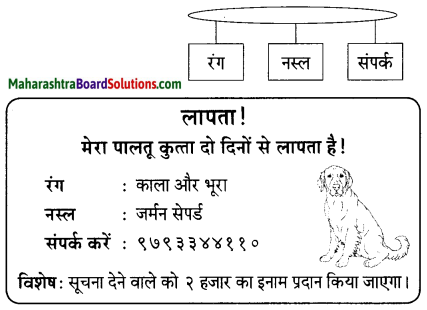
![]()
मैलिक सृजन :
प्रश्न 1.
अपने परिसर में लावारिस जानवरों की बढ़ती मौलिक सृजन संख्या एवं उनसे होने वाली परेशानियों के बारे में संबंधित अधिकारी को पत्र लिखकर सूचना दीजिए।
उत्तर:
संतोष वर्मा
5/सी रूप दर्शन, रामपुर थाना।
दिनांक – 20 जून, 2017।
सेवा में,
श्रीमान पशु अधिकारी जी,
नगर परिषद, थाना।
विषयः परिसर में लावारिस जानवरों की बढ़ती संख्या के संबंध में शिकायत-पत्र।
माननीय महोदय,
मैं शहर के रामपुर क्षेत्र का निवासी हूँ। पिछले कुछ दिनों से हमारे परिसर में लावारिस पशुओं की संख्या बढ़ती जा रही है। अब तो दूसरे कस्बों के पशु भी यहाँ आकर रहने लगे हैं। इन जानवरों की वजह से चारों तरफ गंदगी फैली हुई है। बच्चों को खेलने के लिए परिसर में साफ़ जगह नहीं बची है। महानगर के अधिकारी या कर्मचारी इस तरफ ध्यान नहीं दे रहे हैं।
अत: आपसे निवेदन है कि नागरिकों की सुविधा को ध्यान में रखते हुए शीघ्र ही उचित कार्यवाही करने की कृपा करें।
कष्ट के लिए क्षमाप्रार्थी हूँ।
धन्यवाद!
भवदीय,
संतोष वर्मा।
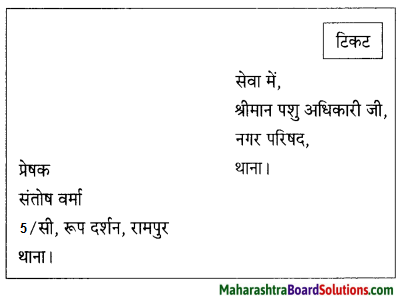
आसपास :
प्रश्न 1.
किसी पशु चिकित्सक से पालतू प्राणियों की सही देखभाल करने संबंधी मार्गदर्शन प्राप्त कीजिए।
उत्तर:
मैं एक दिन अपने पालतू जानवरों के देखभाल से संबंधित जानकारी प्राप्त करने पशु चिकित्सक के पास गया, तो उन्होंने बताया कि हमें अपने पालतू प्राणियों के साथ अच्छा व्यवहार करना चाहिए तथा उनकी सही देखभाल करनी चाहिए। पालतू जानवरों को न तो बहुत कम और न ही बहुत ज्यादा भोजन देना चाहिए। जब उन्हें भूख लगे तभी भोजन देना चाहिए। उनके भोजन और पानी पीने के बर्तन को दिन में कम-से-कम एक बार अवश्य साफ करना चाहिए।
पालतू जानवरों को घुमाने के लिए भी ले जाना चाहिए। बहुत से जानवरों के सामाजीकरण के लिए शारीरिक स्पर्श महत्त्वपूर्ण होता है। अत: उनके साथ खेलना चाहिए तथा उन्हें सहलाना चाहिए। उन्हें चोट नहीं पहुँचानी चाहिए। उन्हें नियमित रूप से पशु-चिकित्सक के पास ले जाना चाहिए।
![]()
बिल्ली का बिलुंगड़ा Summary in Hindi
लेखक-परिचय :
राजेंद्र लाल हांडा जी एक प्रसिद्ध कथाकार हैं। आपकी रचनाएँ पत्र-पत्रिकाओं में हमेशा प्रकाशित होती रहती हैं। सम सामयिक विषयों पर आपकी रचनाएँ सामाजिक समस्याओं को उद्घाटित करती हैं।
गद्य-परिचय :
हास्य कहानी : जीवन की किसी घटना का रोचक, प्रवाही वर्णन कहानी होती है। इसमें किसी सत्य का उद्घाटन होता है। हास्य कहानी में इसे हल्के-फुलके हँसी के अंदाज में प्रस्तुत किया जाता है।
प्रस्तावना : प्रस्तुत पाठ ‘बिल्ली का बिलंगुड़ा’ में लेखक हांडा जी ने हास्य के माध्यम से गलतफ़हमी के कारण उत्पन्न विशेष स्थितियों का वर्णन किया है।
![]()
सारांश :
पिछले दिनों लेखक के घर में बहुत चूहे हो गए थे। वे घर के सामान का बहुत नुकसान कर रहे थे। अनाज की सुरक्षा के लिए लोहे के ढोल (डिब्बे) बनवाए गए। ये ढोल भी कारगर नहीं हुए। उसमें भी चूहे घुसने लगे। मित्रों ने घर में एक बिल्ली पालने का सुझाव दिया और बिल्ली लाई भी गई। बिल्ली की खूब खातिर होने लगी। बच्चे उसे रोटी और दूध देने लगे। कुछ दिनों में बिल्ली ने पूरी तरह चूहों का सफाया कर दिया। सब लोग बड़े खुश हुए। दो महीने बाद लोग चूहे को भूल गए और बिल्ली से तंग आ गए। क्योंकि अब बिल्ली की आदत बदल गई। अब वह मौका मिलते ही दूध, दही, भोजन आदि सपरचट कर देती।
लेखक को बिल्ली से पीछा छुड़ाने की चिंता होने लगी। उनका नौकर अमरू बड़ा होशियार था। रात को उसने एक खाली बोरी में दो रोटियाँ डालकर रख दी। बिल्ली जैसे ही रोटी की लालच में बोरी के अंदर झपटी, नौकर ने तुरंत बोरी का मुँह पकड़ लिया और रस्सी से मुँह बाँध दिया। लेखक ने अमरू से बिल्ली को कहीं दूर छोड़ने को कहा, जहाँ से वह वापस न आ सके।
दूसरे दिन सुबह अमरू बोरी कंधे पर लटका कर उसे छोड़ने चल दिया। रास्ते में कुछ लोगों को शक हुआ की बोरी में बच्चा है। दो आदमी उसके पीछे हो लिए। उन्होंने देखा कि बोरी अंदर से हिल रही है। उन्हें विश्वास हो गया कि इस बदमाश ने किसी बच्चे को पकड़ा है। देखते-देखते पचासों आदमी इकट्ठा हो गए। सब लोगों ने उसे घेर लिया।
पुलिस थाना भी बहुत दूर नहीं था। एक व्यक्ति दौड़कर पुलिस वाले को भी बुला लाया। शोर होने पर लेखक भी घर से बाहर आया, देखा कि भीड़ ने नौकर को घेर रखा है। थानेदार ने अमरू को मारने की धमकी दी तो उसने बोरी का मुँह खोल दिया और बिल्ली का बिलंगुड़ा छलाँगें मारता हुआ भाग गया। दरोगा जी झेंप गए और अमरू हँसता हुआ घर आ गया।
![]()
शब्दार्थ :
- विचारधारा – सोच
- परंपरा – प्रथा
- घपले – गड़बड़ी
- बहुतेरे – बहुत तरह के
- ढोल – लोहे का ड्रम
- कारगर – उपयोगी
- परामर्श – सलाह
- आपत्ति – ऐतराज
- चुनांचे – इसलिए
- विधिपूर्वक – ठीक तरह से
- काबू – वश
- मात – हार
- रवैया – रंग-ढंग, ढंग
- जी में – दिल में
- कढ़े हुए – निकाले हुए
- हजामत – दाढ़ी बनाना
- गुसलखाने – स्नानघर
- छप्परवाले – जिसके ऊपर छप्पर पड़ा हो
- अल्पभाषी – कम बोलने वाला
- मसखरा – मज़ाकिया
- गिरोह – दल
- लपक कर – तेजी से
- हवालात – कारागार
- दसियों – दसों लोग
- हुक्म – आदेश
- गवाह – साक्षी
- नीयत – इरादा
- बेंत – मज़बूत-लचीले डंठलवाली लता
- सनसनी – सन्नाटा, खलबली
- सुराग – (यहाँ अर्थ) पता, खोज
![]()
मुहावरे :
- मौका लगना – अवसर मिलना।
- सिर चढ़ जाना – उदंडता के लिए खुली छूट देना।
- टूट पड़ना – आक्रमण करना।
- व्यस्त होना – तल्लीन होना।
- परामर्श करना – राय लेना।
- एक न चलना – कुछ न कर सकना।
- तंग आना – परेशान होना।
Hindi Lokbharti 9th Digest Answers Pdf पहली इकाई
- चाँदनी रात Question Answer
- बिल्ली का बिलुंगड़ा Question Answer
- कबीर (पूरक पठन) Question Answer
- किताबें Question Answer
- जूलिया Question Answer
- ऐ सखि ! (पूरक पठन) Question Answer
- डाॅक्टर का अपहरण Question Answer
- वीरभूमि पर कुछ दिन Question Answer
- वरदान माँगूँगा नही Question Answer
- रात का चौकीदार (पूरक पठन) Question Answer
- निर्माणों के पावन युग में Question Answer




















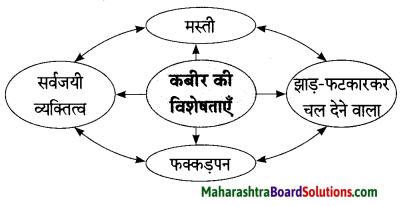
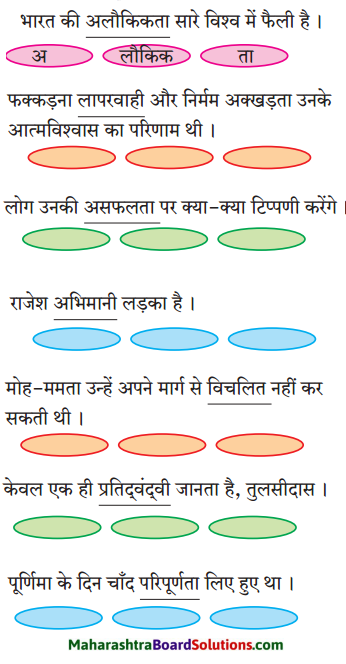

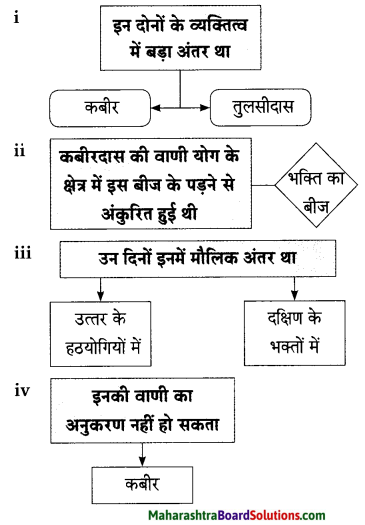
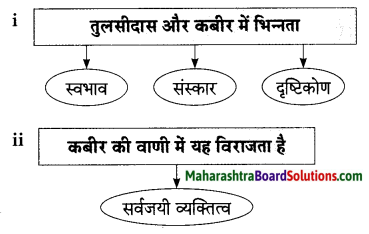
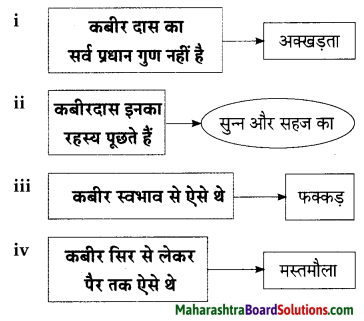
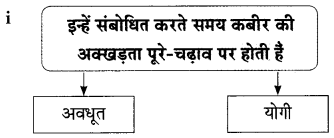
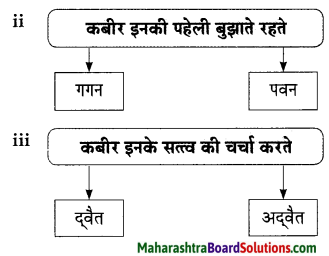
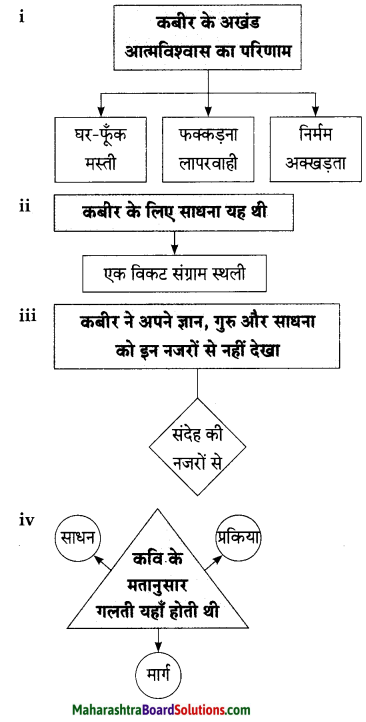

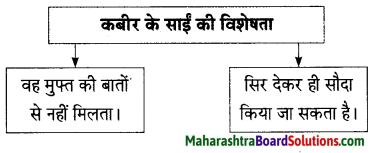
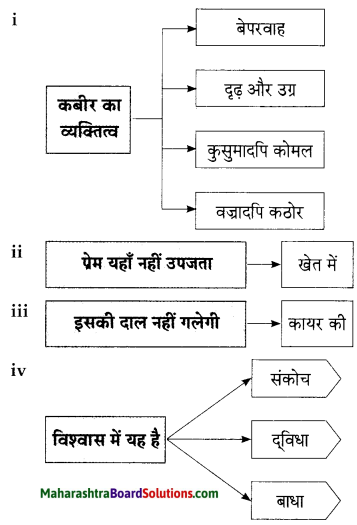
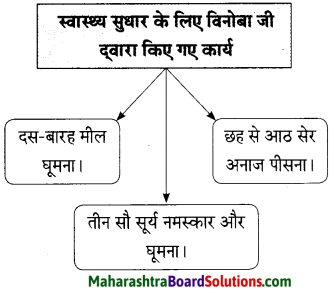

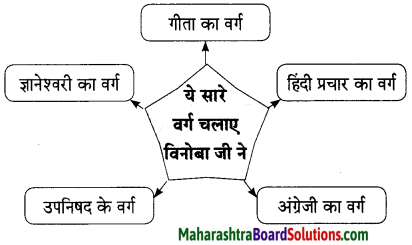
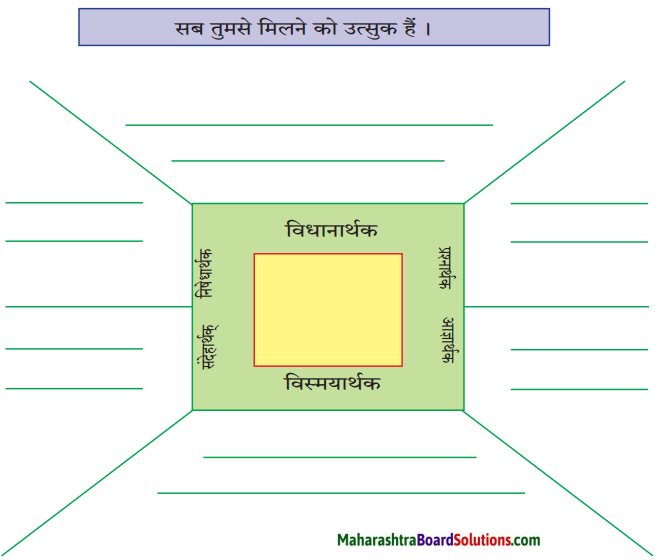
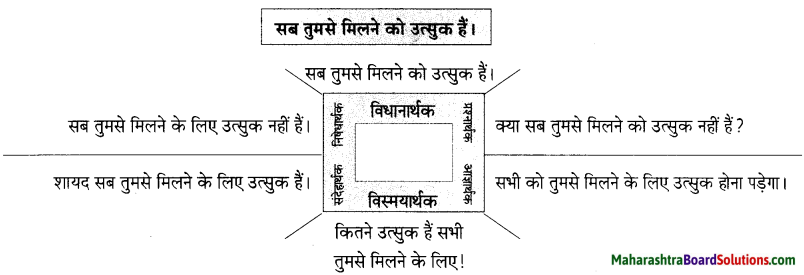


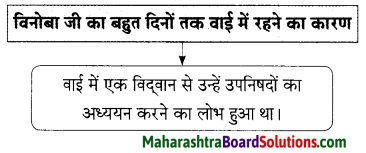
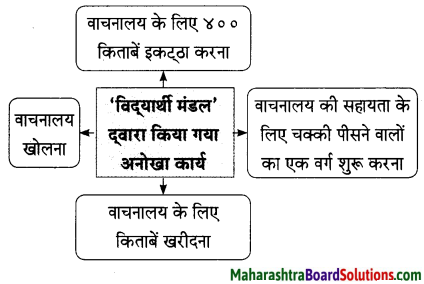
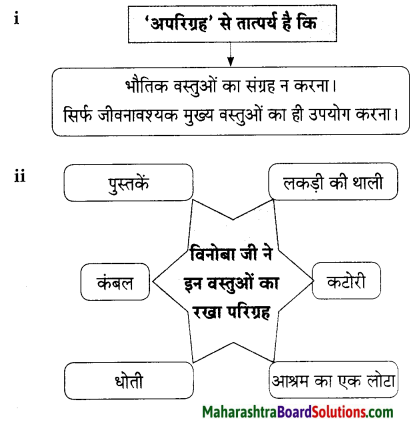

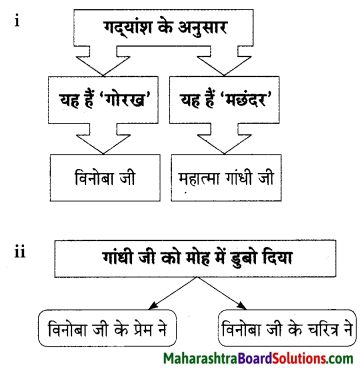
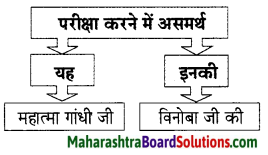
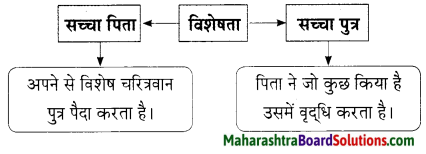
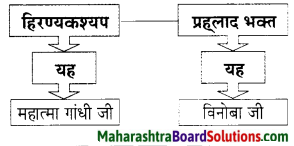


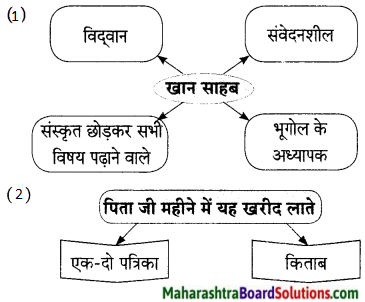
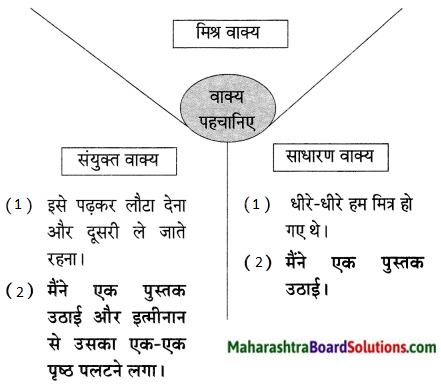
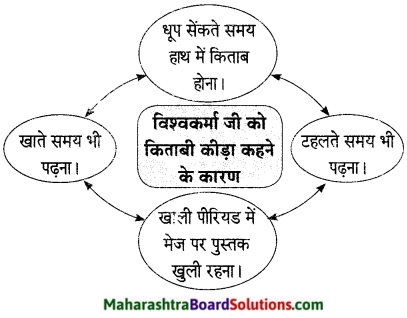
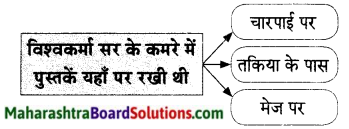
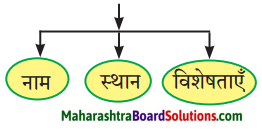
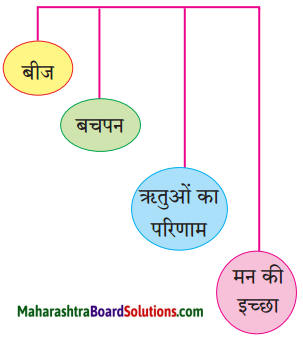
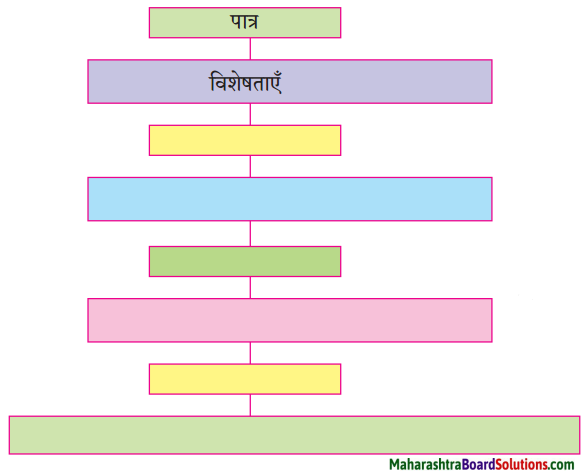

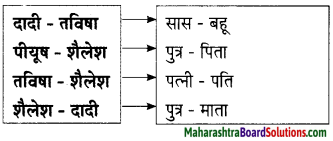
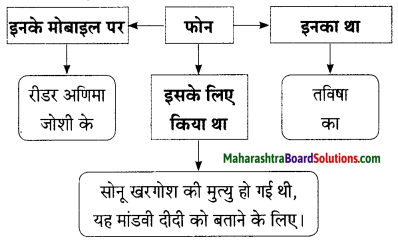
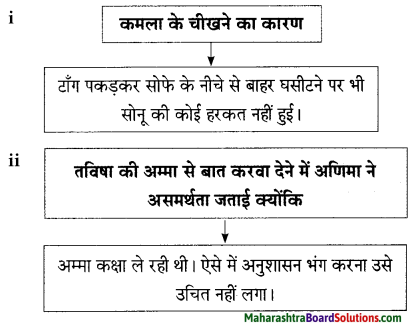
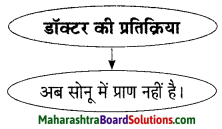
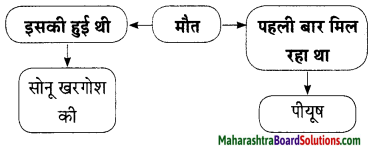
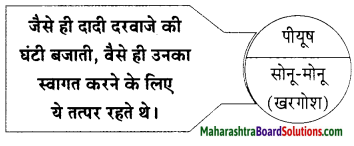


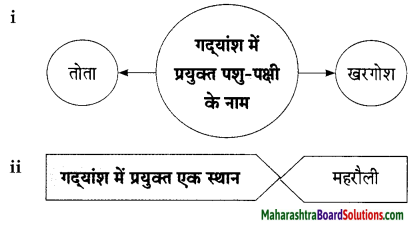
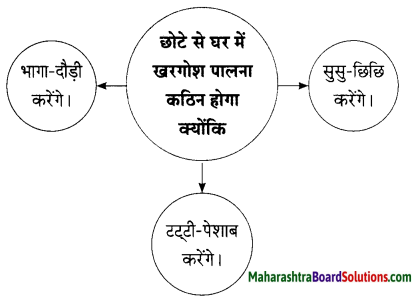
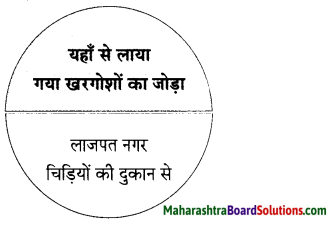

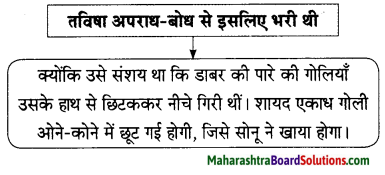




















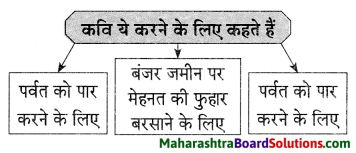

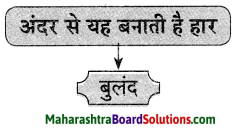
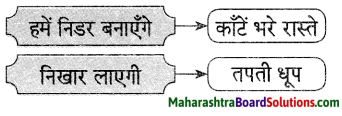
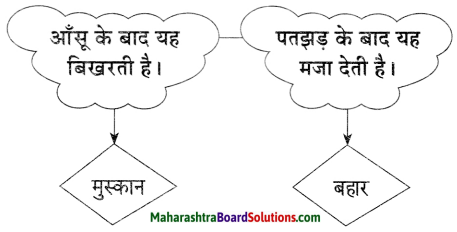

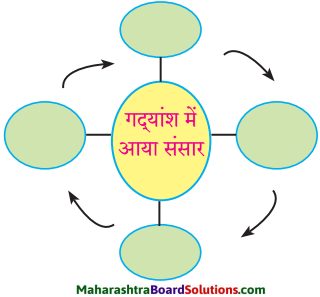
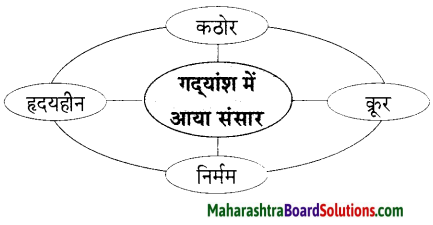


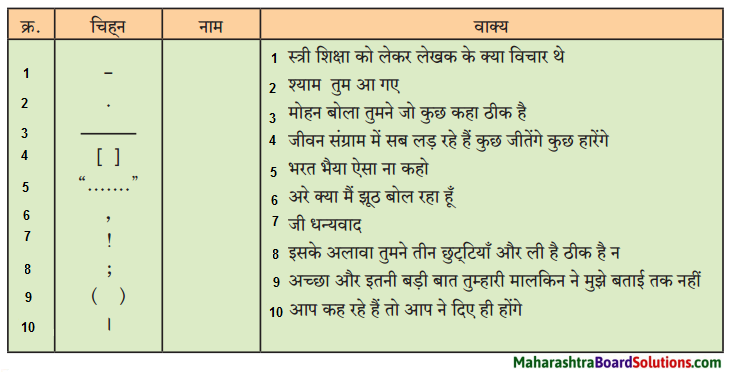
 Hindi Lokbharti 9th Answers Chapter 5 जूलिया Additional Important Questions and Answers
Hindi Lokbharti 9th Answers Chapter 5 जूलिया Additional Important Questions and Answers

